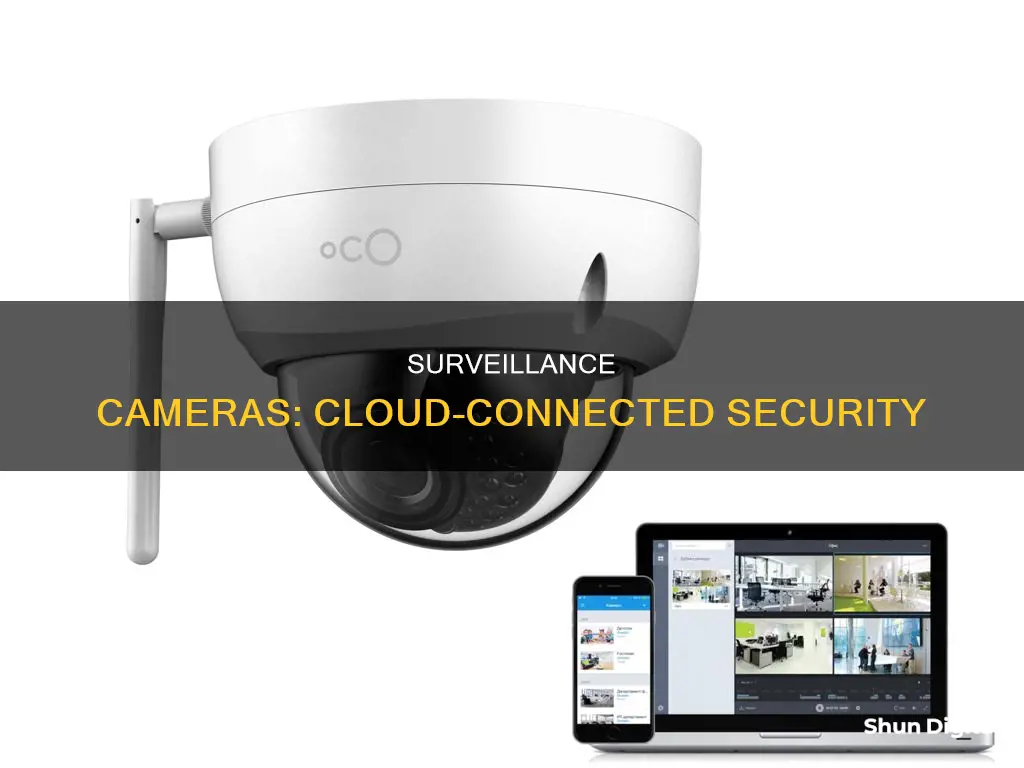
Surveillance cameras with cloud storage are an increasingly popular alternative to traditional security systems that use DVRs or NVRs. Cloud-based systems record and store footage in cloud storage using an internet connection, doing away with the need for complex on-site hardware and maintenance. This makes them a more cost-effective, flexible, and convenient option for businesses, especially those with multiple sites, as they can be accessed and controlled remotely. Cloud-based surveillance cameras are wireless and can be adjusted from multiple devices, including smartphones, computers, and tablets. They also benefit from regular automatic security updates, which protect them from bad actors.
| Characteristics | Values |
|---|---|
| Storage | Cloud-based security camera systems record and store footage in cloud storage using an internet connection |
| Hardware | Cloud-based security camera systems are hardware-free, eliminating the need for complex on-site hardware gateways and NVRs |
| Accessibility | Footage can be accessed from anywhere with an internet connection, providing remote visibility and on-the-go access |
| Maintenance | Cloud-based systems reduce the need for constant hardware maintenance and updates |
| Costs | Cloud-based security camera systems can reduce costs associated with hardware maintenance and upgrades |
| Security | Cloud-based systems offer improved security with end-to-end encryption and regular security updates |
| AI Integration | Advanced AI capabilities can enhance basic motion detection, detecting people, vehicles, and other relevant activities |
| Setup | Cloud-based security camera systems are easy to set up and use, with plug-and-play options available |
What You'll Learn
- Surveillance cameras with cloud storage offer a cost-effective solution, charging just a subscription fee
- Cloud-based surveillance systems are flexible and scalable, allowing users to change their cloud plan as required
- Cloud storage is generally safer than on-site storage, with a very low risk of losing data
- Surveillance footage can be accessed and shared from anywhere with an internet connection
- Cloud-based surveillance systems are hardware-free, removing the need for complex on-site hardware

Surveillance cameras with cloud storage offer a cost-effective solution, charging just a subscription fee
Surveillance cameras with cloud storage are an increasingly popular option for businesses and individuals alike. This is largely because cloud storage offers a cost-effective solution, charging just a subscription fee, and removing the need for costly hardware.
On-site storage solutions such as DVRs and NVRs can be cumbersome and costly to maintain. They require large upfront costs for hardware purchases, and often have fixed storage capacities, which may result in you paying for more than you need, or not having enough storage. In contrast, cloud storage is simply a location to store your camera footage and is an alternative to using a disk (NVR, DVR) on-site.
With cloud storage, you can easily upgrade your plan as required, rather than guessing how much storage you will need with a recorder. Cloud storage is scalable and flexible, and you can often choose to record on motion, meaning you can use your cloud storage more efficiently as you're only recording footage when motion is detected.
In addition, cloud storage provides a centralized platform to remotely view footage from multiple sites, making it perfect for businesses with multiple locations. It also makes your CCTV system proactive by alerting you to motion detected on your camera and allowing you to view the footage from anywhere.
Some cloud storage providers also offer advanced AI features that can enhance your camera's basic motion detection by detecting people, vehicles, and other activity that matters.
Overall, surveillance cameras with cloud storage offer a cost-effective and flexible solution, charging just a subscription fee, and providing a range of features that make it a superior option to traditional on-site storage solutions.
Spotting Fake Surveillance Cameras: What to Look For
You may want to see also

Cloud-based surveillance systems are flexible and scalable, allowing users to change their cloud plan as required
Cloud-based surveillance systems are an increasingly popular alternative to traditional video surveillance systems. They are also known as Video Surveillance as a Service (VSaaS). Cloud-based surveillance offers flexibility and scalability, allowing users to change their cloud plan as required. This flexibility is particularly beneficial for businesses with multiple sites or locations.
One of the key advantages of cloud-based surveillance is that it eliminates the need for complex on-site hardware and gateways. Cameras can be connected directly to the cloud, providing fail-safe surveillance. This reduces the cost and maintenance associated with traditional hardware systems, such as DVRs and NVRs. Cloud-based surveillance also offers improved data security compared to on-site storage, as it does not require port-forwarding, which can leave systems vulnerable to cyber-attacks.
Cloud-based surveillance systems are scalable, allowing users to easily adjust their storage plans according to their needs. This is especially useful for businesses or organisations with multiple sites, as it provides a centralised viewing platform. Users can access footage from anywhere in the world with an internet connection, making it a convenient and flexible option.
Additionally, cloud-based surveillance systems can be integrated with advanced AI capabilities, enhancing basic motion detection to detect people, vehicles, and other specific objects or activities. This adds a proactive element to security systems, allowing users to receive real-time alerts and notifications when certain events occur.
Overall, cloud-based surveillance systems offer a flexible, scalable, and cost-effective solution for video surveillance, making them a popular choice for businesses and organisations seeking to modernise their security systems.
Focusing Film Cameras: Mastering the Art of Sharp Shots
You may want to see also

Cloud storage is generally safer than on-site storage, with a very low risk of losing data
Surveillance cameras with cloud storage are becoming increasingly popular, with many businesses and local governments opting for this modern approach to video surveillance. Cloud storage offers a host of benefits over traditional on-site storage methods, including enhanced security, convenience, and cost-effectiveness.
One of the key advantages of cloud storage is its security features. Cloud storage providers employ robust access control mechanisms, user authentication methods, and data encryption to protect stored files and data. This multi-layered approach ensures that files are protected from unauthorized access, internal risks, and cyber threats. Additionally, cloud storage eliminates the physical threats associated with on-site storage, such as theft, damage, and natural disasters, further reducing the risk of losing data.
The cloud also offers scalability and flexibility that on-site storage cannot match. With unlimited storage space and the ability to connect an unlimited number of cameras, cloud storage is ideal for businesses and local governments with multiple locations. It allows for remote management of video surveillance, providing authorized users with access to footage from anywhere at any time. This level of accessibility and centralized viewing is not possible with traditional on-site storage.
In terms of cost, cloud storage can also be more economical than on-site storage. By eliminating the need for complex on-premise hardware, cloud storage reduces maintenance costs and hardware upgrades. This is especially beneficial for multi-site organizations that would otherwise require recorders at each location. Cloud storage also provides a robust backup solution, ensuring data redundancy and minimizing the risk of data loss.
While some may be hesitant to adopt new technology, cloud storage has proven to be a safer and more reliable option for video surveillance. With enhanced security features, accessibility, and cost-effectiveness, cloud storage is a clear choice for those seeking to protect their valuable data and footage.
Troubleshooting Camera Raw: Why It Reads Wrong
You may want to see also

Surveillance footage can be accessed and shared from anywhere with an internet connection
Cloud-based surveillance cameras offer a host of benefits over traditional, non-cloud-based alternatives. One of the most significant advantages is the ability to access and share surveillance footage from anywhere with an internet connection. This feature is especially useful for businesses with multiple sites or locations, as it allows users to monitor all their cameras from one device.
For example, Camcloud is a hardware-free cloud video surveillance platform that allows users to connect their cameras directly to the cloud. This eliminates the need for complex on-site hardware and provides users with a single, secure location to store their footage. With Camcloud, users can access their surveillance footage through a mobile app, providing peace of mind and allowing them to keep an eye on their operations 24/7 from anywhere.
Another example is Videoloft, a cloud video surveillance provider that offers a centralised viewing platform. With Videoloft, users can view footage from multiple sites in one place, making monitoring much easier. Videoloft also allows users to add unlimited multiple users to their cameras and set permission levels, making it easy to share footage with others.
In addition to providing remote access and sharing capabilities, cloud-based surveillance cameras offer several other benefits. Cloud storage is generally safer than on-site storage, as it is less susceptible to physical threats such as theft and damage. It also reduces costs associated with hardware maintenance and upgrades and provides a scalable and flexible solution that can be easily adapted to changing requirements.
Overall, cloud-based surveillance cameras offer a convenient and secure way to access and share surveillance footage from anywhere with an internet connection. With features like centralised viewing platforms and mobile apps, businesses and individuals can easily monitor their premises and share footage when needed.
Troubleshooting Snapchat's Persistent Portrait Mode Camera Issue
You may want to see also

Cloud-based surveillance systems are hardware-free, removing the need for complex on-site hardware
Cloud-based surveillance systems offer a hardware-free approach to security, removing the need for complex on-site hardware and the costs associated with hardware maintenance and upgrades. This means that there is no requirement for on-site hardware gateways and NVRs (Network Video Recorders) at each location, which can be costly and time-consuming to manage, especially for enterprises with multiple sites.
Instead, cameras can be connected directly to the cloud, providing a fail-safe and streamlined surveillance solution. This direct connection to the cloud offers increased accessibility, allowing users to access and manage their camera footage from anywhere in the world with an internet connection. This is particularly beneficial for businesses with multiple sites, as it provides a centralised viewing platform, where footage from all sites can be viewed and managed through a single login.
Additionally, cloud-based surveillance systems offer a scalable and flexible solution. By choosing a cloud service provider, users can adjust their cloud plan as needed, rather than committing to a set amount of storage with a recorder. This flexibility also extends to the ability to connect existing IP and analogue cameras to the cloud, allowing users to choose the best security camera brands for their specific requirements.
Furthermore, cloud-based surveillance systems can provide robust backup solutions, ensuring that footage is not vulnerable to theft or damage, which is often a concern with on-site recorders. Cloud storage also reduces the risk of data loss due to physical threats such as theft or damage, enhancing the overall security of the surveillance system.
By adopting cloud-based surveillance, organisations can modernise their security operations, enhance business operations, and reduce costs associated with traditional on-premise video surveillance systems.
Vivint Camera Deter Mode: How Does It Work?
You may want to see also
Frequently asked questions
Cloud surveillance is the remote storage of video recordings on the internet. It does not require any physical equipment or wires, only an internet connection.
Cloud-based systems record and store footage in cloud storage using an internet connection. Traditional camera systems store their video data on a physical hard drive using wired connections.
Cloud surveillance offers several benefits over traditional NVR systems, including remote access from anywhere, indefinite access, and over-the-air firmware upgrades. It also reduces costs, the need for personnel, and constant hardware maintenance.
To set up cloud surveillance, you need to establish a secure, direct connection from your camera directly to the cloud. This can be done by connecting your camera to a cloud video surveillance platform, which will send its data to the cloud for storage.







